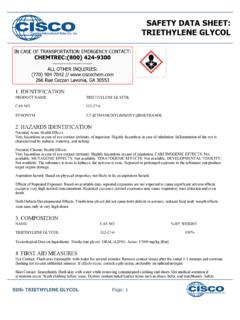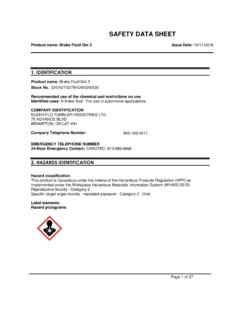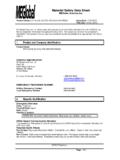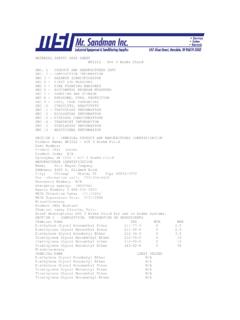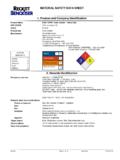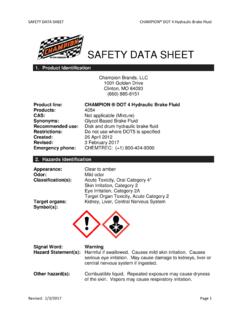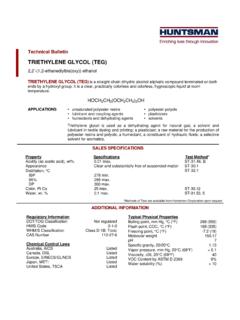Transcription of Flo-Perm Long Life 5 Years 60/40 Pre-mix Antifreeze ...
1 Flo-Perm Long Life 5 Years 60/40 Pre-mix Antifreeze / coolant safety data sheet SDS No. 006, Date of issue: 2016-12-06, p. 1 of 10 SECTION 1: Identification Product identifier Product name Flo-Perm Long Life 5 Years 60/40 Pre-mix Antifreeze / coolant Part No. 2063A, 93063 Recommended Use Antifreeze / coolant Restrictions on Use None known Supplier's details Name Vulsay Industries Ltd. Address 35 Regan Road Brampton, Ontario L7A 1B2 Canada Telephone 905 846 2200 Fax 905 846 2249 Emergency phone number(s) 24 hours EMERGENCY Phone # - 1-800-468-1760 SECTION 2: Hazard identification Classification of the substance or mixture - Acute toxicity, oral (chapter ), Cat.
2 4 - Specific target organ toxicity, single exposure (chapter ), Cat. 2 - Toxic to reproduction (chapter ), Cat. 2 - Eye damage/irritation (chapter ), Cat. 2B GHS label elements, including precautionary statements Pictogram Signal word Warning Hazard statement(s) H302 Harmful if swallowed Flo-Perm Long Life 5 Years 60/40 Pre-mix Antifreeze / coolant safety data sheet SDS No. 006, Date of issue: 2016-12-06, p. 2 of 10 H373 May cause damage to organs (kidneys) through prolonged or repeated exposure H360 May damage fertility or the unborn child H320 Causes eye irritation Precautionary statement(s) P202 Do not handle until all safety precautions have been read and understood.
3 P201 Obtain special instructions before use. P264 Wash hands thoroughly after handling. P280 Wear protective gloves, protective clothing, eye protection. P270 Do not eat, drink or smoke when using this product. P260 Do not breathe mist, vapours, spray. P301+P310 IF SWALLOWED: Immediately call a POISON CENTER/doctor. P301+P330+P331 IF SWALLOWED: Rinse mouth. DO NOT induce vomiting. P305+P351+P338 IF IN EYES: Rinse cautiously with water for several minutes. Remove contact lenses if present and easy to do. Continue rinsing. P337+P313 If eye irritation persists: Get medical advice/attention.
4 P302+P352 IF ON SKIN: Wash with plenty of water. P362+P364 Take off contaminated clothing and wash it before reuse. P308+P313 IF exposed or concerned: Get medical advice/attention. P501 Dispose of contents/container in accordance with local regulations SECTION 3: Composition/information on ingredients Component Concentration (volume) ETHYLENE GLYCOL (CAS no.: 107-21-1; EC no.: 203-473-3; Index no.: 603-027-00-1) <=60 % DIETHYLENE GLYCOL (CAS no.: 111-46-6; EC no.: 203-872-2; Index no.: 603-140-00-6) 1 - 3 % Hydrated inorganic acid, organic acid salts (CAS no.)
5 : Mixture) < 5 % Water (CAS no. 7732-18-5) < 40% SECTION 4: First-aid measures Description of necessary first-aid measures If inhaled IMMEDIATELY leave the contaminated area; take deep breaths of fresh air. If symptoms (such as wheezing, coughing, shortness of breath, or burning in the mouth, throat, or chest) develop, call a physician and be prepared to transport the victim to a hospital. Provide proper respiratory protection to rescuers entering an unknown atmosphere. Whenever possible, Self-Contained Breathing Apparatus (SCBA) should be used; if not available, use a level of protection greater than or equal to that advised under Respirator Recommendation.
6 In case of skin contact IMMEDIATELY flood affected skin with water while removing and isolating all contaminated clothing. Gently wash all affected skin areas thoroughly with soap and water. If symptoms such as redness or irritation develop, get medical attention. In case of eye contact First check the victim for contact lenses and remove if present. Flush victim's eyes with water or normal saline solution for 20 to 30 minutes while Flo-Perm Long Life 5 Years 60/40 Pre-mix Antifreeze / coolant safety data sheet SDS No. 006, Date of issue: 2016-12-06, p.
7 3 of 10 simultaneously calling a hospital or poison control center. Do not put any ointments, oils, or medication in the victim's eyes without specific instructions from a physician. Get medical attention immediately. If swallowed DO NOT INDUCE VOMITING. IMMEDIATELY call a hospital or poison control center. If the victim is conscious and not convulsing, give 1 or 2 glasses of water to dilute the chemical. Be prepared to transport the victim to a hospital if advised by a physician. If the victim is convulsing or unconscious, do not give anything by mouth, ensure that the victim's airway is open and lay the victim on his/her side with the head lower than the body.
8 IMMEDIATELY transport the victim to a hospital. Personal protective equipment for first-aid responders General advice: First Aid responders should pay attention to self-protection and use the recommended protective clothing (chemical resistant gloves, splash protection). If potential for exposure exists refer to Section 8 for specific personal protective equipment. Most important symptoms/effects, acute and delayed Ethylene glycol may be acutely toxic following ingestion. Due to its low volatility and low dermal absorption rate, acute toxicity is unlikely following exposure to ethylene glycol by the inhalation or dermal routes.
9 Acute toxicity following ingestion of ethylene glycol manifests in three phases. The first is characterized by central nervous system (CNS) depression much like in ethanol intoxication, with features including dizziness, agitation, nystagmus, nausea, tachycardia, elevated blood pressure and vomiting between and 12 hours. The second phase at around 12 hours after ingestion is characterized by cardiorespiratory effects, with the development of hyperpnoea, metabolic acidosis, dyspnoea, hyperventilation, tachycardia, cyanosis and elevated blood pressure.
10 A third phase, involving renal toxicity may present 24 36 hours after ingestion with flank pain, renal angle tenderness, acute tubular necrosis, hypercalcaemia, hyperkalaemia and hypomagnesaemia. Oliguria or anuria may occur. Some investigators report a fourth stage characterized by delayed neurological dysfunction. Death may occur after substantial exposures due to cardiopulmonary failure or CNS damage in later stages. Severe intoxication, if survived, may lead to neurological effects including facial paralysis, slurred speech, loss of motor skills and impaired vision.
